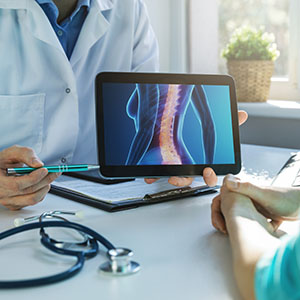Spine Care

Spinal problems are among the most common—and challenging—orthopedic conditions, and often encompass neurological issues. Our team of physiatrists, anesthesiologists, physical therapists, pain management specialists, nurses, and specially trained spine surgeons is trained and equipped to assess and treat spinal problems resulting from injuries, genetic abnormalities, and diseases such as arthritis, sciatica, and scoliosis. Whenever possible, we strive to achieve positive results using non-surgical or minimally invasive techniques.
Back pain can occur for numerous different reasons:
- Trauma
- Aging
- Incorrect body mechanics
- Normal wear and tear
Back pain usually responds to non-surgical treatments:
- Anti-inflammatory medicine
- Ice Heat Massage
- Physical therapy
Most people get better in four to six weeks. Surgery may be considered when non-surgical options have not been successful after six months to a year. The type of surgery to treat back pain will depend on the nature of the injury. Some types of back pain cannot be treated, even with surgery.
Conditions that may require surgery include:
- Scoliosis (curvature of the spine)
- Kyphosis (humpback deformity)
- Spondylolisthesis (segment of the spine slips forward)
- Spinal stenosis (narrowing of the spinal canal)
- Radiculopathy (herniated disc causes nerve irritation and inflammation)
- Degenerative disc disease
There are several different kinds of back surgery.
Spinal Fusion – Spinal fusion involves fusing together two vertebrae (bones) in the spine. This procedure can help relieve pain by eliminating painful motion between vertebrae and providing stability. A bone graft is typically used to help the bones fuse together; screws or rods may be inserted to keep the spine stable while healing. The procedure can be performed through the abdomen, side, back or a combination. Full recovery may take a year or longer.
Discectomy – A discectomy may be done to remove the herniated part of a disc to relieve pressure on a nerve that is causing irritation or inflammation. This procedure often involves removing most or part of the back portion of the vertebra to access the ruptured disc.
Laminectomy – When nerve pressure caused by spinal stenosis is causing pain, the bone overlying the spinal canal can be removed during a surgical procedure called a laminectomy. This enlarges the spinal canal and reduces pain.
Kyphoplasty – This procedure involves injecting bone cement into compressed vertebrae.
SI Joint Fusion – This is a minimally invasive procedure done through a small incision. The goal is to treat pain and dysfunction in the triangular-shaped bone in the lower portion of the spine through the stabilization of joints with implantable devices.
Navigated Spinal Procedures and O-Arm Technology – Both of these options guide surgeons during complex spinal fusion cases using CT imaging.
Spinal Cord Stimulators and Pain Pumps – These are implantable devices that may help to alleviate back pain.
To prevent persistent back problems:
- Exercise to keep the muscles in your back and abdomen strong and flexible
- Lift heavy items properly with your legs
- Maintain a healthy weight
- Don’t smoke
- Have good posture